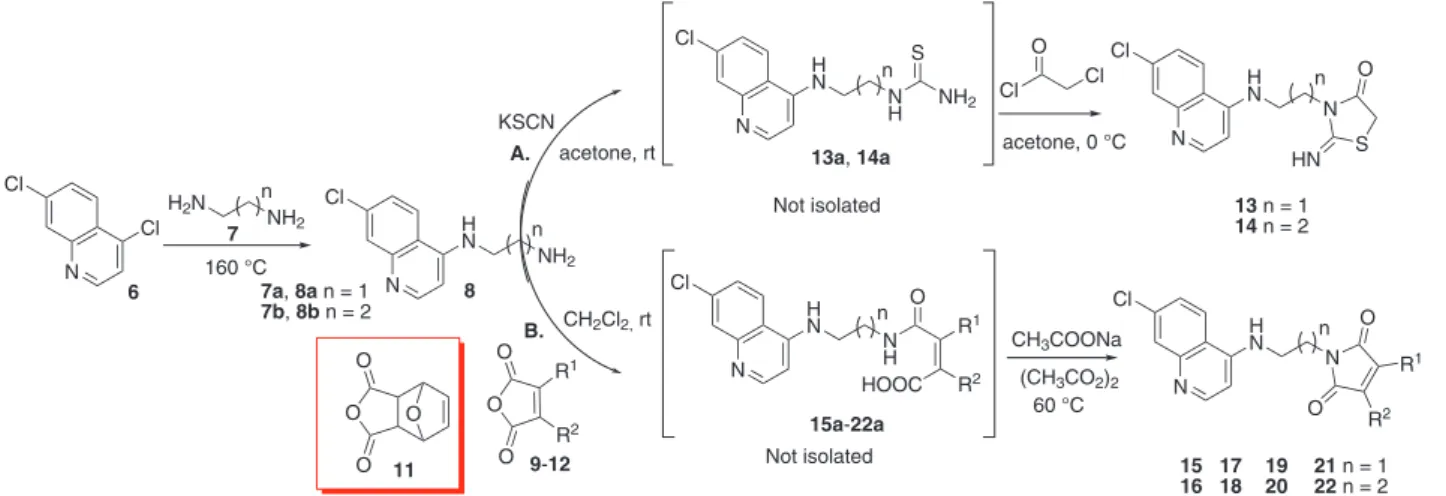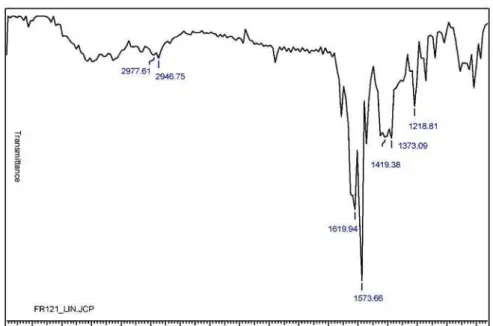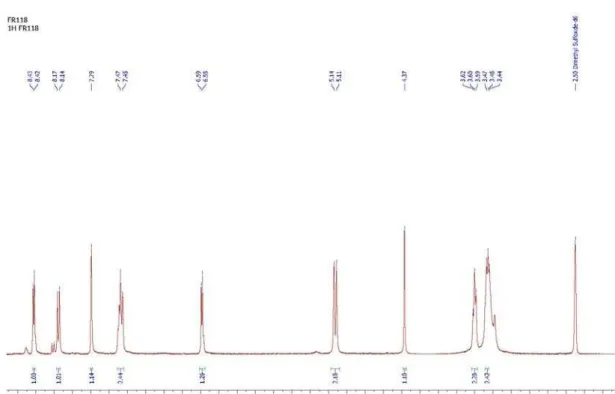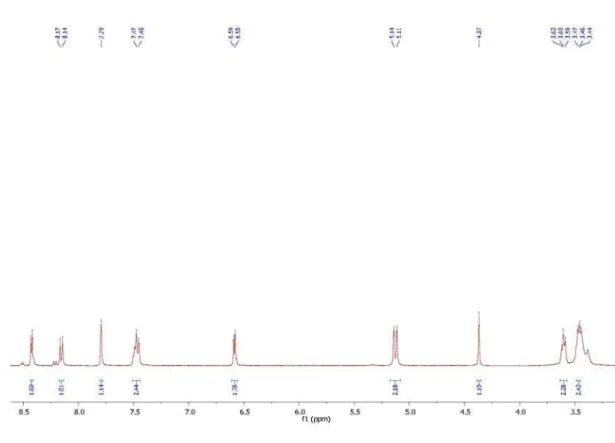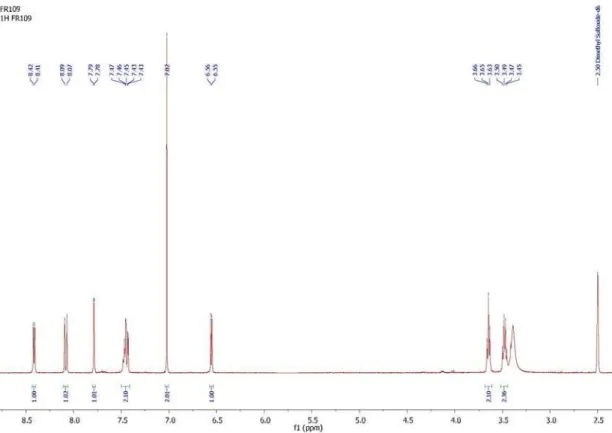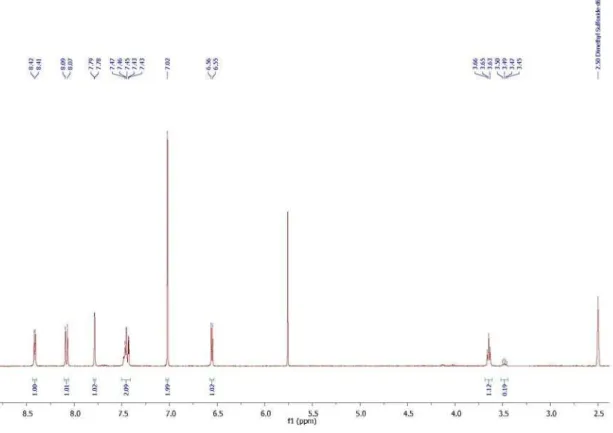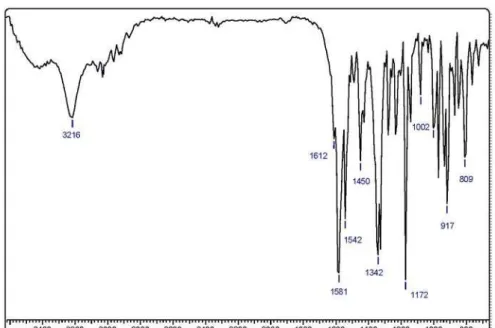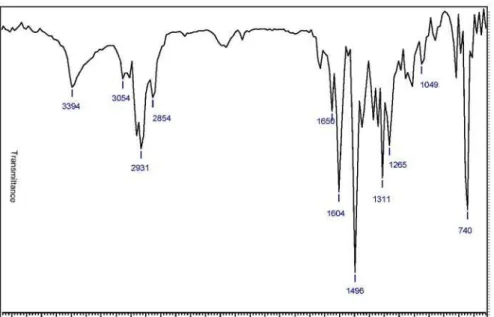Article
J. Braz. Chem. Soc., Vol. 22, No. 9, 1774-1781, 2011. Printed in Brazil - ©2011 Sociedade Brasileira de Química 0103 - 5053 $6.00+0.00
A
*e-mail: kouznet@uis.edu.co
Property-Based Design and Synthesis of New Chloroquine Hybrids via Simple
Incorporation of 2-Imino-thiazolidin-4-one or 1
H
-Pyrrol-2,5-dione Fragments on
the 4-Amino-7-chloroquinoline Side Chain
Fernando A. Rojas and Vladimir V. Kouznetsov*
Laboratorio de Química Orgánica y Biomolecular, Escuela de Química, Universidad Industrial de Santander, A. A. 678, Bucaramanga, Colombia
No presente trabalho realizou-se a síntese de novos N-derivados da 4-amino-7-cloroquinolina modiicando seletivamente o grupo amino terminal das N-(7-cloroquinolin-4-il)-alquildiaminas,
a base do fármaco cloroquina (CQ) mediante a incorporação de sistemas heterocíclicos da 2-imino-tiazolidin-4-ona e 1H-pirrol-2,5-diona. Esses derivados foram selecionados graças às
suas propriedades características, e avaliados mediante crivado virtual empregando as plataformas OSIRIS e Molinspiration. Os derivados quinolínicos assim desenhados e sintetizados poderiam incrementar a atividade antimalárica dos análogos da CQ sem afetar a lipoilia como tem se descrito na literatura, postulando-se como candidatos em posteriores testes biológicos.
In the present work, the syntheses of new 4-amino-7-chloroquinoline N-derivatives were
performed by selective modiication of the side chain amino group of N-(7-chloroquinolin-4-yl)
alkyldiamines, basis framework of chloroquine (CQ) drug through the incorporation of heterocyclic 2-imino-thiazolidin-4-one and 1H-pyrrol-2,5-dione systems. These potential activity modulators
were selected thanks to their characteristic properties, and evaluated by virtual screening employing the OSIRIS and Molinspirations platforms. Designed and synthesized quinolinic derivatives could increase the antimalarial activity of CQ analogues without affecting the lipophilicity as described in literature, suggesting them as candidates for further biological assessments.
Keywords:4-amino-7-chloroquinolines, 2-imino-thiazolidin-4-ones, 1H-pyrrol-2,5-diones,
molecular hybrids, property-based design, drug-like properties, antimalarial agents
Introduction
Drug-like properties are an integral element of drug discovery projects. This term became commonly used following the pivotal work of Lipinski and co-workers.1,2
Drug-like property optimization is an important area of antiparasitic drug discovery, in general, and antiplasmodial agents development, in particular. Investigation during the last two decades has shown the increasing chloroquine (CQ) resistance and the emerging meloquine resistance by
Plasmodium falciparum; thus, there is still a high potential
for developing new active antimalarials.3-5
The development of antiplasmodial agents directed towards a single therapeutic target has shown not to be the best strategy within the progress against this devastating disease.In this sense, recently the antimalarial activity modulation has been examined by means of the systematic
modiication of the quinoline core or the 4-aminoquinoline side chain, inding that the last generate highly active compounds against multidrug resistant parasites.3-6 The
tertiary amino group present in most 4-aminoquinoline drugs is considered responsible for the drug accumulation within the parasite digestive vacuole, and to provide
lipophilicity because of its basic character.7 Nevertheless,
the introduction of structural features that highly decrease this group basicity has proved to increase the antimalarial activity of several CQ analogues.3,5 These discoveries
established the amino side chain modifications as an alternative strategy for the new and selective antimalarials development. These modiications consist mainly in the introduction of small N-heterocycles whose ring structure
would increase the antimalarial activity or potentiate other bioeffects.
In this sense, thiazolidin-4-one derivatives are well known for their antidiarrheic,8 anticonvulsant,9
as for increasing the antimalarial activity of CQ analogues.4
However, different systems as 2-imino-thiazolidin-4-one
1 and its 5-aryliden derivative 2,13 despite their
anti-inlammatory and antiviral activity,13-15 have been less
studied in medicinal chemistry, and awake our particular interest on using these systems as a chloroquine amino group modiication. As well as thiazolidin-4-one systems, cyclic imides, e.g. 1H-pyrrol-2,5-diones 3, 4, are structural
frameworks present in several active molecules, principally against cancer cell lines16-21 (Figure 1). These properties are
helpful activity modulatorswithin of the development of new antimalarial agents.
Based on this evidence, in the present work, the design and synthesis of potential new 4-aminoquinoline drug-like molecules were developed, through the systematic analysis of the desired product structure and the selective modification of the amino group, incorporating the biologically privileged 2-imino-thiazolidin-4-ones and cyclic N-imides scaffolds using a new strategy of
“property-based design”.22 These systems are present in diverse
bioactive molecules, and additionally could prevent the enzymatic dealkylation without affecting lipophilicity, and increase antimalarial activity of CQ, as described in literature.
Results and Discussion
The present work describes the eficient synthesis of new 4-amino-7-chloroquinoline derivatives functionalized
with 2-imino-tihazolidin-4-one or 1H-pyrrol-2,5-dione
systems separated by a short aminoalkyl chain. These hybrids, obtained by synthetic pathways reported in recent scientiic literature, correspond to the previous virtual screening performed using the OSIRIS and Molinspiration platforms.23-27 The obtained results evidence the potential
in further biological studies of these derivatives thanks to their considerable drug-score and excellent reaction yields.
Rational molecular design
The principal idea of molecular hybrids formation is the lead antimalarial agent development with a potential and selective activity against multidrug resistant P. falciparum
strains. The 2-imino-thiazolidin-4-one and 1H-
pyrrol-2,5-dione systems possess the adequate characteristics to be considered as reversal agent candidates within the new
quinoline derivatives construction.
Using the Lipinski’s rule25 and drug-score criterion,24
the structures of a new series of CQ analogues based on the 4-amino-7-chloroquinoline skeleton and these
N-heterocyclic moieties were evaluated, assembling these
compounds from synthetic and commercially available precursors (Figure 2).
Employing the Molinspiration software,28 the planned
compounds 13-22 were subjected to the Lipinski’s rule of
ive analysis (drug-likeness), which indicates if a chemical substance can be orally active in humans.1,24 Currently, there
are many approaches that assess a compound drug-likeness based on topological descriptors, ingerprints of molecular drug-likeness structure keys or other properties such as TPSA. In the Molinspiration program, the occurrence frequency of each fragment is determined within the collection created by shreddering 3300 traded drugs, as well as 15000 commercially available chemicals yielding a complete list of all available fragments.23 In this work,
the Molinspiration program was used for the fragment based drug-likeness calculation of all desired compounds Figure 1. Bioactive molecules bearing small N-heterocyclic frameworks.
Figure 2. Property-based design and planned 4-aminoquinoline series fused with small N-heterocyclic moieties.
N H S O NH HO N O O O NH2 N N O O N O S N HOOC N S O CHAr HN 1 3 2 4 N H N N Cl O O O N H N N Cl O O N H N N Cl O O N H N N Cl O O N H N N Cl S O HN
13 n = 1
14 n = 2
15 n = 1
16 n = 2
17 n = 1
18 n= 2
n
n n
n
n
21 n = 1 22 n= 2
19 n = 1 20 n= 2
N H N Cl Me N Et Et 5 N H N NH2 Cl n
small N-heterocycles +
Property-Based Design and Synthesis of New Chloroquine Hybrids J. Braz. Chem. Soc.
1776
also comparing them with CQ structure 5. Conversely to
the CQ as reference, the obtained calculations demonstrate that all analyzed compounds contain high bioavailability properties, and fulil all parameters established by this rule (molecular weight = 269.73-408.91, log P = 2.66-4.92,
nON = 2-6, and nOHNH = 0-4)1,27 (Table 1). TPSA has
been shown to be a very good descriptor characterizing drug absorption, including intestinal absorption, bioavailability, Caco-2 permeability and blood-brain barrier penetration.25,26
Prediction results for the compounds 13-22 molecular
properties (Table 1), show TPSA values between 63 and 69 Å2 conirming their drug-relevant properties.
In order to assess the possible pharmacological properties of hybrids 13-22, a toxicity proile evaluation
was performed employing the OSIRIS software,29 as it
may point to the presence of some fragments generally responsible for the irritant, mutagenic, tumorigenic, or reproductive effects in these molecules.24 As shown in
Figure 3 (left panel), with the exception of compounds 21
and 22, all desired products represented low or moderate
biological risks.
Moreover, we used the OSIRIS program to predict the compounds drug-score (Figure 3, right panel). Products
17-20 revealed the effect of the anhydride structure over
this parameter, and can be attributed to the presence of substitutions on positions 2 or 5 of the pyrrolidone ring. This theoretical data is a clear evidence of the biological potential of the designed 4-aminoquinoline series, and support further experimental bioactivity assessments, pointing these hybrids as lead compounds with a low toxicity risk proile.
Synthesis of 4-aminoquinoline derivatives bearing N-heterocyclic systems on the side chain amino group
Final compounds 13-22 and their
4-amino-7-chloroquinoline precursors 8 were synthesized by direct
and effective protolcols.6,30 The side chain amino group
Table 1. Calculated Lipinski’s rule of ive parameters for the 4-aminoquinoline bearing N-heterocyclic frameworks
Compound Parameters
log P TPSAa / Å2 MW / (g mol-1) nONb nOHNHc RBNd Violations
13 2.09 69.09 320.8 5 1 4 0
14 2.34 69.09 334.8 5 1 5 0
15 2.16 63.99 301.7 5 1 4 0
16 2.43 63.99 315.8 5 1 5 0
17 2.54 63.99 315.8 5 1 4 0
18 2.09 63.99 329.8 5 1 5 0
19 2.16 71.53 369.8 6 1 4 0
20 2.43 71.53 383.8 6 1 5 0
21 3.89 63.99 351.8 5 1 4 0
22 4.17 63.99 365.8 5 1 5 0
CQ 5.00 28.16 319.9 3 1 8 1
aPolar surface area; bnumber of hydrogen bond acceptors; cnumber of hydrogen bond donors; dnumber of rotatable bonds.
(compound 8) was bound to the 4,7-dichloroquinoline core
by means of nucleophilic aromatic substitution SNAr, using
4,7-dichloroquinoline 6 and the corresponding commercial
diaminoalkanes 7. This reaction was performed under
relux, in the presence of excess of diamine as solvent. Different reported methodologies on 2-imino-thiazolidin-4-one synthesis imply the isolation and puriication of the corresponding thioureas as intermediates, and their subsequent chloroacetylation.18-20 In this work, the quinoline
derivatives bearing the 2-imino-tiazolidin-4-one framework
13 and 14 were obtained in good yields as white solids
from the quinoline diamines 8, potassium thiocyanate,
and chloroacetyl chloride in anhydrous acetone at room
temperature, without isolation of thiourea derivatives 13a
and 14a (Scheme 1, route A).
On the other hand, formation of two isomers imino-thiazolidinone and N-alkylimino-thiazolidinone has been
described by Ottaná et al.,14 and explained by the possible
condensation of chloroacetyl chloride with the two different nitrogen atoms on the thiocarbonyl group, causing the two different thiols intermediates generation. However, according to gas chromatography and nuclear magnetic resonance (NMR) analysis, compounds 13 and 14 were
obtained exclusively as 2-imino-thiazolidin-4-ones in a 75-78% yield (Table 2), and N
-alkylimino-thiazolidin-4-one formation was not detected. Single isomer synthesis
Table 2. The 4-aminoquinoline derivatives functionalized with N-heterocyclic systemsa
Compound NR1R2 n mp / °C Condensed
formula Rfb IR (KBr) νmax / cm-1 GC-MS tR / min, m/z (%) Yield / %
13 1 182-185 C14H13ClN4OS 0.4 3329(NH), 1619(C=O), 1573(C=N) 18.2, 320 (M+•, 65) 78
14 2 170-175 C15H15ClN4OS 0.5 3331(NH), 1622(C=O), 1575(C=N) 18.2, 213 (M+•, 65) 75
15 1 195-198 C15H12ClN3O2 0.6 3216(NH), 1712(C=O) 31.1, 301 (M+•, 65) 98
16 2 85-90 C16H14ClN3O2 0.5 3440(NH), 1697(C=O) 31.1, 315 (M+•, 65) 75
17 1 148-150 C16H14ClN3O2 0.4 3239(NH), 1697(C=O) 32.1, 329 (M+•, undetected) 85
18 2 150-153 C17H16ClN3O2 0.7 3239(NH), 1697(C=O) 36.1, 329 (M+•, undetected). 80
19 1 195-198 C19H14ClN3O3 0.7 3239(NH), 1697(C=O) 35.0, 367 (M+•, undetected) 85
20 2 152-155 C20H16ClN3O3 0.6 3240(NH), 1697(C=O) 35.6, 381 (M+•, undetected) 80
21 1 200-203 C19H14ClN3O2 0.5 3409(NH), 1697(C=O) 43.2, 351 (M+•, 70) 90
22 2 165-167 C20H16ClN3O2 0.4 3255(NH), 1712(C=O) 36.2, 365 (M+•, undetected) 88 aElemental analyses were within ± 0.4 of theoretical values; busing (20:1) ethyl acetate-methanol mixtures on a silufol UV254 TLC aluminium sheet.
Scheme 1. Preparation of molecular hybrids 13-22. N Cl H N NH2 n N Cl H N N S HN O
acetone, 0 °C Cl O Cl N Cl H N N H n NH2 S KSCN acetone, rt n 8
13a, 14a
O O O N Cl H N N O O n CH2Cl2, rt
N Cl H N N H HOOC O n 15a-22a R1 R2 R1 R2
9-12
(CH3CO2)2 CH3COONa R1 R2 O O O O 11 N Cl H2N NH2 n Cl 160 °C 6 60 °C 7
13 n = 1
14 n = 2
15 16
17 18
21 n = 1
22 n = 2
19 20 A. B. Not isolated Not isolated
7a, 8a n = 1
Property-Based Design and Synthesis of New Chloroquine Hybrids J. Braz. Chem. Soc.
1778
is probably favoured by the higher electron availability of the NH2 group, compared with the highly hindered NH
group bearing the N-alkylaminoquinoline framework on
intermediates 13a and 14a. In order to extend the molecular
library of hybrids between CQ and N-heterocyclic systems,
new 4-aminoquinolines functionalized with 1H
-pyrrol-2,5-dione framework were prepared. Synthesis of compounds
15-22 was performed according to the procedure established
by Deng et al.,20 starting from quinoline diamines 8 and
cyclic anhydrides 9-12 (Scheme 1, route B). Intramolecular
cyclization of the amic acid intermediates 15a-22a was
accomplished using acetic anhydride in presence of sodium acetate (5% mol). Most of the anhydride precursors employed were commercially available. Nevertheless, for preparation of hybrids 19 and 20, synthesis of anhydride 11
through intermolecular cycloaddition of furan and maleic anhydride was developed according to Deng et al.16
Commonly employed conditions within the N-alkylimide
synthesis require high temperatures and long reaction times, reaching moderate yields.31 In this work, 4-aminoquinoline
derivatives functionalized with N-alkylimide system were
obtained in high yield (85-98%), using lower reaction temperature and shorter reaction times (Table 2).
The structures of all new CQ hybrids 13-22 were
strongly conirmed by NMR, IR and GC-MS analysis (Table 2 and Experimental part).
In summary, in this paper, we have reported a versatile and convenient route for the synthesis of novel hybrids between 4-aminoquinoline and N-heterocyclic systems
previously designed. Obtained theoretical data awakes further experimental assays and establish these molecules as lead compounds with a low toxicity risk proile. The preliminary antimalarial evaluation of some of these hybrid analogues, prepared here against P. falciparum, has been
studied.32 Based on these results further synthesis of new
molecular hybrids by changing the substituents on the small heterocyclic ring and quinoline nucleus in order to enhance the antimalarial activity is being investigated and will be reported in due course.
Experimental
Materials and methods
Melting points (mp, uncorrected) were determined on a Fisher-Johns melting point apparatus. The IR spectra were recorded on a Lumex Infralum FT-02 spectrophotometer in
KBr. 1H NMR spectra were recorded on Bruker AM-400
spectrometers, using DMSO-d6. Chemical shifts are reported
in ppm. Signals are designated as follows: s, singlet; d, doublet; dd, doublet of doublets; ddd, doublet of doublets
of doublets; t, triplet; dt, doublet of triplets; td, triplet of doublets; q, quartet; quint., quintet; m, multiplet; br, broad. A Hewlett Packard 5890a series II Gas Chromatograph interfaced to an HP 5972 Mass Selective Detector (MSD) with an MP MS Chemstation Data system was used for MS identiication at 70 ev using a 60 m capillary column coated with hp-5 [5%-phenyl-poly(dimethyl-siloxane)]. Elemental analyses were performed on a Perkin Elmer 2400 Series II Analyzer and were within ± 0.4 of theoretical values. The reaction progress was monitored using thin layer chromatography on a silufol UV254 TLC aluminium sheet.
Molecular design was performed based on structure activity relationship studies, and virtual screening analysis reported in literature.23,24 Lipinki’s rule of ive parameters
were calculated using the Molinspiration virtual platform (http://www.molinspiration.com/services/). The toxicity risk proile evaluation was accomplished employing the OSIRIS program available free at http://www.organic-chemistry.org/prog/peo. The OSIRIS and Molinspiration Property Explorers shown in these pages are an integral part of some pharmaceutical companies’ in-house substance registration system. They allow drawing chemical structures and calculating on-the-ly various drug-relevant properties whenever a structure is valid. Prediction results are valued and colour coded. Properties with high risks of undesired effects like mutagenicity or a poor intestinal absorption are shown in red, whereas a green colour indicates drug conform behaviour (Figure 3; see colors online).
Chemistry
General procedure for synthesis of 4-amino-7-chloro-quinolines (8)6,30
4.00 g (20.2 mmol) of 6 and α,ω-diaminoalkane (7a, b)
(10.1 mmol) was heated at 80 °C for 1 h with stirring and subsequently at 140-150 °C for 6-7 h with continued stirring. The reaction mixture was cooled to room temp and basiied with 10% NaOH (70 mL). The resultant mixture was extracted with chloroform-methanol (20:1, 4 × 50 mL). The combined extracts were washed with brine, dried over anhydrous Na2SO4, concentrated under reduced pressure
and the residue (10 mL) was precipitated by the addition of n-heptane (70 mL). The solid was puriied by washing with 40 mL ethyl ether. Physicochemicalcharacteristics of the obtained compounds 8 are given in the Supplementary
Information.
General procedure for synthesis of 4-amino-7-chloro-quinoline and 2-imino-thiazolidin-4-one hybrids (13, 14)
agitation. Subsequently, 1.00 g (4.52 mmol) of quinoline diamines (8a or 8b) in acetone were added dropwise to
the above solution and the reaction mass was stirred for 7 h according to TLC analysis. Without any further puriication process, over the resulting mass, triethylamine (3.00 g, 29.60 mmol) and then a solution of chloroacethyl chloride in anhydrous acetone (1.10 g, 9.30 mmol) was added during 30 min at 0 ºC. The reaction mass was heated to room temperature and stirred over a 24 h period. Resulting yellowish mass was neutralized with 30 mL of sodium bicarbonate 10%, and extracted with ethyl acetate (2 × 30 mL). The organic layer was dried over Na2SO4 and concentrated under vacuum. Finally, hybrids 13, 14 were puriied by lash column chromatography
using (20:1) ethyl acetate and methanol mixtures as eluents. Physicochemicalcharacteristics of the obtained compounds are given in Table 2.
3-(2-((7-Chloroquinolin-4-yl)amino)ethyl)-2-imino-thiazolidin-4-one (13):1H NMR (400 MHz, DMSO-d
6)
d 8.42 (d, 1H, J 5.3 Hz, 2-H), 8.15 (d, 1H, J 9.0 Hz, 5-H),
7.79 (d, 1H, J 1.3 Hz, 8-H), 7.46 (d, 1H, J 8.9 Hz, 6-H),
6.58 (d, 1H, J 5.3 Hz, 3-H), 5.13 (d, 1H, J 10.9 Hz, C=NH),
4.37 (s, 2H, CH2), 3.61 (t, 2H, J 6.7 Hz, CH2), 3.48-3.43
(m, 2H, CH2), 7.45-7.49 (m, 1H, NH); 13C NMR (100 MHz,
DMSO-d6), d 171.8, 158.3, 154.5, 152.3, 149.3, 134.8, 129.2, 124.4, 121.7, 117.5, 99.2, 50.1, 46.5, 30.2.
3-(3-((7-Chloroquinolin-4-yl)amino)propyl)-2-imino-thiazolidin-4-one(14):1H NMR (400 MHz, DMSO-d
6)
d 8.42 (d, 1H, J 5.3 Hz, 2-H), 8.15 (d, 1H, J 9.0 Hz, 5-H),
7.79 (d,1H, J 1.3 Hz, 8-H), 7.46 (d, 1H, J 8.9 Hz, 6-H), 6.58
(d, 1H, J 5.3 Hz, 3-H), 5.13 (d, 1H, J 10.9 Hz, C=NH), 4.37
(s, 2H, CH2), 3.61 (t, 2H, J 6.7 Hz, CH2), 3.48-3.43 (m, 2H,
CH2), 2.02 (m, 2H, CH2), 7.45-7.49 (m, 1H, NH); 13C NMR
(100 MHz, DMSO-d6) d 172.1, 158.5, 154.9, 152.7, 150.3, 135.1, 129.4, 124.8, 121.7, 118.0, 99.0, 40.9, 38.5, 26.2.
General procedure for synthesis of chloroquine and 1H-pyrrol-2,5-dione hybrids (15-22)
1.0 g (4.24 mmol) of quinoline diamines (8a or 8b)
was dissolved in 5.0 mL of anhydrous dichloromethane under vigorous agitation. Then, a solution of anhydride (9-11) (0.7 g, 4.24 mmol) in dichloromethane was added
dropwise to the above solution for 30 min at 0 °C, stirring the white precipitate formed for 2 h. Solvent excess was distilled under reduced pressure, and the remaining solid was iltered and washed with diethyl ether. Without any further puriication process, the obtained amic acid
15a-22a was mixed with 0.05 g (0.61 mmol) of sodium
acetate and dissolved in 1.0 mL acetic anhydride. Reaction
temperature was adjusted to 60 ºC and kept constant over a 5 h period. Finally, the reaction mass was allowed to cool and neutralized with sodium bicarbonate (1 mol L-1).
The coloured precipitate was iltered, washed with cold water, and air dried. Hybrids 15-22 were inally puriied by
lash column chromatography using (20:1) ethyl acetate-methanol mixtures as mobile phase and TLC control (Rf).
Physicochemicalcharacteristics of the obtained compounds are given in Table 2.
1-(2-((7-Chloroquinolin-4-yl)amino)ethyl)-1H-pyrrol-2,5-dione(15):1H NMR (400 MHz, DMSO-d
6) d 8.42 (d,
1H, J 5.4 Hz, 2-H), 8.08 (d, 1H, J 9.0 Hz, 5-H), 7.79 (d,
1H, J 2.2 Hz, 8-H), 7.47 (m, 1H, NH), 7.44 (dd, 1H, J 9.0,
2.2 Hz, 6-H), 7.02 (s, 2H, 3’(4’)-H), 6.55 (d, 1H, J 5.5 Hz,
3-H), 3.65 (t, 2H, J 6.2 Hz, 2’-H), 3.48 (q, 2H, J 6.1 Hz,
1’-H); 13C NMR (100 MHz, DMSO-d6) d 170.5, 154.5,
152.7, 149.3, 134.9, 135.8, 129.4, 124.7, 121.6, 117.5, 99.2, 46.9, 50.5.
1-(3-((7-Chloroquinolin-4-yl)amino)propyl)-1H-pyrrol-2,5-dione(16):1H NMR (400 MHz, DMSO-d
6)
d 8.39 (d, 1H, J 5.4 Hz, 2-H), 7.98 (d, 1H, J 9.0 Hz, 5-H),
7.69 (d, 1H, J 2.1 Hz, 8-H), 7.46 (m, 1H, NH), 7.46 (dd,
1H, J 9.0, 2.1 Hz, 6-H), 7.11 (s, 2H, 4’(5’)-H), 6.55 (d,
1H, J 5.4 Hz, 3-H), 3.65 (t, 2H, J 6.2 Hz, 3’-H,), 3.48 (q,
2H, J 6.1 Hz, 1’-H), 2.03-1.99 (m, 2H, 2’-H); 13C NMR
(100 MHz, DMSO-d6) d 169.5, 155.3, 153.4, 148.7, 134.9, 136.1, 130.1, 124.8, 121.5, 117.3, 99.0, 40.9, 39.0, 25.9.
1-(2-((7-Chloroquinolin-4-yl)amino)ethyl)-3-methyl-1H-pyrrol-2,5-dione (17):1H NMR (400 MHz, DMSO-d
6)
d 8.44 (d, 1H, J 5.4 Hz, 2-H), 8.06 (d, 1H, J 9.1 Hz, 5-H),
7.79 (d, 1H, J 2.3 Hz, 8-H), 7.45 (dd, 1H, J 2.2 and 9.0 Hz,
6-H), 7.36 (t, 1H, J 7.0 Hz, NH), 6.56 (d, 1H, J 5.5 Hz,
3-H), 5.76 (s, 1H, 3’-H,), 4.03 (q, 2H, J 7.1 Hz, 2’-H), 3.44
(m, 2H, 1’-H), 1.59 (s, 3H, CH3); 13C NMR (100 MHz,
DMSO-d6) d 173.9, 169.8, 154.5, 153.3, 150.1, 145.6, 135.1, 129.3, 128.6, 124.7, 121.5, 118.0, 98.91, 46.6, 51.1, 10.9.
1-(3-((7-Chloroquinolin-4-yl)amino)propyl)-3-methyl-1H-pyrrol-2,5-dione (18):1H NMR (400 MHz, DMSO-d6) d 8.39 (d, 1H, J 5.4 Hz, 2-H), 8.16 (d, 1H, J 9.1 Hz, 5-H),
7.79 (d, 1H, J 2.3 Hz, 8-H), 7.45 (dd, 1H, J 2.1 and 9.1 Hz,
6-H), 7.38 (t, 1H, J 7.0 Hz, NH), 6.59 (d, 1H, J 5.4 Hz, 3-H),
5.78 (s, 1H, 4’-H), 4.13 (q, 2H, J 7.1 Hz, 3’-H), 3.46 (m,
2H, 1’-H), 2.02 (m, 2H, 2’-H) 1.61 (s, 3H, CH3); 13C NMR
Property-Based Design and Synthesis of New Chloroquine Hybrids J. Braz. Chem. Soc.
1780
2 ( 2 ( ( 7 C h l o ro q u i n o l i n 4 y l ) a m i n o ) e t h y l ) -4,7-dihydro-1H-4,7-epoxyisoindole-1,3(2H)-dione (19):
1H NMR (400 MHz, DMSO-d
6) d 8.43 (d, 1H, J 5.3 Hz,
2-H), 8.09 (d, 1H, J 9.0 Hz, 5-H), 7.80 (d, 1H, J 2.0 Hz,
8-H), 7.45 (dd, 1H, J 9.0, 2.1 Hz, 6-H), 7.41 (t, 1H, J 5.8 Hz,
NH), 6.58 (d, 1H, J 5.4 Hz, 3-H), 6.55 (s, 2H, 5’-H), 5.12
(s, 2H, 4’-H), 3.62 (t, 2H, J 6.6 Hz, 2’-H), 3.44-3.41 (m,
2H), 2,93 (s, 2H, 3’-H); 13C NMR (100 MHz, DMSO-d6)
d 173.2, 154.7, 152.7, 150.1, 142.6, 135.4, 134.9, 129.3, 124.8, 121.6, 118.2, 99.2, 87.9, 51.4, 46.6.
2-(3-((7-Chloroquinolin-4-yl)amino)propyl)-4,7-dihydro-1H-4,7-epoxyisoindole-1,3(2H)-dione (20):
1H NMR (400 MHz, DMSO-d
6) d 8.38 (d, 1H, J 5.4 Hz,
2-H), 8.23 (d, 1H, J 9.0 Hz, 5-H), 7.78 (d, 1H, J 2.1 Hz,
8-H), 7.45 (dd, 1H, J 8.9, 2.0 Hz, 6-H), 7.28 (t, 1H, J 5.2 Hz, NH), 6.55 (s, 2H, 6’-H), 6.40 (d, 1H, J 5.5 Hz,
3-H), 5.15 (s, 2H, 5’-H), 3.50 (t, 2H, J 6.8 Hz, 1’-H), 3.22
(m, 2H, 3’-H), 2.93 (s, 2H, 4’-H), 1.90-1.81 (m, 2H, 2’-H);
13C NMR (100 MHz, DMSO-d6) d 172.9, 154.3, 152.7,
149.2, 142.5, 135.3, 135.1, 129.2, 124.9, 121.6, 117.5, 98.9, 88.3, 41.1, 39.8, 26.6.
2-(2-((7-Chloroquinolin-4-yl)amino)ethyl)isoindoline-1,3-dione (21):1H NMR (400 MHz, DMSO-d6) d 8.42 (d, 1H, J 5.4 Hz, 2-H), 8.05 (d, 1H, J 9.0 Hz, 5-H), 7.85-7.80
(m, 4H, HAr), 7.78 (d, 1H, J 2.1 Hz, 8-H), 7.51 (t, 1H,
J 6.0 Hz, NH), 7.41 (dd, 1H, J 9.0, 2.2 Hz, 6-H), 6.63 (d,
1H, J 5.4 Hz, 3-H), 3.83 (t, 2H, J 6.1 Hz, 2’-H), 3.61-3.56
(m, 2H, 1’-H); 13C NMR (100 MHz, DMSO-d6) d 167.9,
155.3, 153.7, 150.2, 134.9, 132.2, 132.0, 129.3, 124.8, 123.7, 121.5, 117.6, 99.2, 51.4, 46.6.
2 - ( 3 - ( ( 7 - C h l o ro q u i n o l i n - 4 - y l ) a m i n o ) p ro p y l ) isoindoline-1,3-dione(22):1H NMR (400 MHz, DMSO-d6) d 8.36 (d, 1H, J 5.4 Hz, 2-H), 8.19 (d, 1H, J 9.0 Hz, 5-H),
7.84-7.79 (m, 4H, HAr), 7.76 (d, 1H, J 2.2 Hz, 8-H), 7.42
(dd, 1H, J 9.0, 2.2 Hz, 6-H), 7.28 (t, 1H, J 5.4 Hz, NH),
6.45 (d, 1H, J 5.5 Hz, 3-H), 3.71 (t, 2H, J 6.9 Hz, 1’-H),
3.34-3.29 (m, 2H, 3’-H), 2.05-1.98 (m, 2H, 2’-H); 13C NMR
(100 MHz, DMSO-d6) d 168.1, 154.3, 153.1, 149.2, 135.1, 132.2, 132.0, 129.4, 124.8, 124.5, 121.6, 117.5, 98.9, 55.7, 40.9, 26.1.
Supplementary Information
Supplementary information (Figures S1-S20) is available free of charge at http://jbcs.sbq.org.br as PDF ile.
Acknowledgments
This work was supported by grant of COLCIENCIAS (grant CENIVAM, contract No. 432-2004). FARR also thanks UIS for the fellowship.
References
1. Lipinski, C. A.; Lombardo, F.; Dominy, B. W.; Feeney, P. J.;
Adv.Drug Deliv. Rev. 1997, 23, 3.
2. Kerns, E. H.; Di, L.; Drug-like Properties: Concepts, Structure Design and Methods,1st ed., Elsevier Inc: Amsterdam, 2008,
pp. 6-16.
3. Kouznetsov, V. V.; Gómez-Barrio, A.; Eur. J. Med. Chem.2009, 44, 3091.
4. Solomon, R.; Haq, W.; Srivastava, K.; Puri, K.; J. Med. Chem. 2007, 50, 394.
5. Idan, C.; Cailean, C.; Smith, J.; Lehman, J.; Gut, J.; Philip, J.; Chibalea, K.; Bioorg. Med. Chem.2005, 13, 3249.
6. Madrid, P.; Liou, A.; De Risi, J.; Guy, R.; J. Med. Chem. 2006, 49, 4535.
7. Egan, T.; Hunter, R.; Kaschula. C.; Marques, H.; Misplon, A.; Walderen, J.; J. Med. Chem. 2000, 43, 283.
8. Diurno, M. V.; Mazzoni, O.; Izzo, A. A.; Bolognese, A.;
Il Farmaco 1999, 54, 579.
9. Archana, V. K.; Kumar, V. S.; Eur. J. Med. Chem.2002, 37,
873.
10. Tomašić, T.; Zidar, N.; Mueller-Premru, M.; Kikelj, D.; Peterlin, L.; Eur. J. Med. Chem.2010, 45, 1667.
11. Zhou, H.; Wu, S.; Zhai, S.; Liu, A.; Sun, Y.; Li, R.; Zhang, Y.; Ekins, S.; Swaan, P. W.; Fang, B.; Zhang, B.; Yan, B.; J. Med. Chem. 2008, 51, 1242.
12. Rawal, R. K.; Prabhakar, Y. S.; Katti, S. B.; De Clercq, E.;
Bioorg. Med. Chem.2005, 13, 6771.
13. Ameya, A.; Nandini, R.; Arkivoc2007, 16, 148.
14. Ottaná, R.; Maccari, R.; Barreca, M.; Bruno, G.; Rotondo, A.; Rossi, A.; Bioorg. Med. Chem.2005, 13, 4243.
15. Sedlák, M.; Hanusek, J.; Macháek, V.; Hejtmánková, L.;
J. Heterocyclic Chem. 2002, 39, 1105. 16. Deng, L.; Hu, Y.; Synth. Comm.2007, 38, 157.
17. Dharam, P.; Vikas, B.; Birinder, J.; Nalin, K.; Sheetal, G.; Ranju, B.; Palusczak, A.; Hartmann, R.; Il Farmaco2005, 60, 283.
18. Kok, S.; Bambari, R.; Yuen, M.; Lin, E.; Bioorg. Med. Chem. 2008, 16, 3626.
19. Unangst, P.; Connor, D.; Cetenko, W.; Sorenson, R.; Kostland, C.; Sircar, J.; Wright, C.; Scherier, D.; Dyer, R.; J. Med. Chem.
1994, 37, 322.
20. Deng, L.; Liu, F.-M.; Wang, H.-Y.; J. Heterocyclic Chem.2005,
21. Piarulli, U.; Regalia, N.; Mortoni, A.; Martinelli, M.; Gagliardia, S.; Tetrahedron Lett. 2004, 43, 6623.
22. Van de Waterbeemd, H.; Smith, D. A.; Beamount, K.; Walker, K.; J. Med. Chem. 2001, 44, 1313.
23. Mandal, S.; Moudgil, M.; Mandal, S. K.; Eur. J. Pharmacol. 2009, 625, 90.
24. El-Azab, A. S.; Al-Omar, M. A.; Ala, A. M. Naglaa, A. A.; Eur. J. Med. Chem.2010, 45, 4188.
25. Chohan, Z. H.; Youssoui, M. H.; Jarrahpour, A.; Ben Hadda, T.; Eur. J. Med. Chem. 2010, 45, 1189.
26. Ertl, P.; Rohde, B.; Selzer, P.; J. Med. Chem. 2000, 43, 3714. 27. Kuhn, B.; Gerber, P.; Schulz, T.; Stahl, M.; J. Med. Chem.2005,
48, 4040.
28. http://www.molinspiration.com/services/ accessed in June 2010 29. http://www.rcsb.org/pdb/explore.do?structureId=1M17
accessed in June 2010.
30. Solomon, R.; Puri, K.; Srivastava, K.; Katti, S.; Bioorg. Med. Chem. 2005, 13, 2157.
31. Matuszak, N.; Muccioli, G. G.; Labar, G.; Lambert, N. M.;
J. Med. Chem. 2009, 52, 7410.
32. Sánchez, R. N. G.; Pérez-Solorzano, B. M.; Ruiz, J. J. N.; Torres, D. F. A.; Barrio, A. G.; Fernández, A. R. M.; Kouznetsov, V. V.;
Antimalarial Activity of New Quinoline Derivatives (abstract), Xth European Multicolloquium of Parasitology (EMOP 10),
Paris, France, August 24-28, 2008; Kouznetsov, V. V.; Gómez-Barrio, A.; Amado, D. F. T.; Sanchez, R. N. G.; Perez-Solorzano, B. M.; Ruiz, J. J. N.; Fernandez, A. R. M.; Biomedica2009, 29, 249.
Submitted: January 1, 2011
Supplementary Information
S
I
J. Braz. Chem. Soc., Vol. 22, No. 9, S1-S11, 2011. Printed in Brazil - ©2011 Sociedade Brasileira de Química 0103 - 5053 $6.00+0.00
*e-mail: kouznet@uis.edu.co
Property-Based Design and Synthesis of New Chloroquine Hybrids via Simple
Incorporation of 2-Imino-thiazolidin-4-one or 1
H
-Pyrrol-2,5-dione Fragments on
the 4-Amino-7-chloroquinoline Side Chain
Fernando A. Rojas and Vladimir V. Kouznetsov*
Laboratorio de Química Orgánica y Biomolecular, Escuela de Química, Universidad Industrial de Santander, A. A. 678, Bucaramanga, Colombia
N1-(7-Chloroquinolin-4-yl)-ethane-1,2-diamine (8a):
yellowish white solid, yield 75% from 6 and diamine 7a; mp 143-145 °C; IR (KBr) νmax/cm-1: 3248(N-H), 2893(CH2),
1589(N-H), 1142(C-N); GC-MS: tR = 22.13 min, MS (EI)
m/z (%): 221 (M+•, 29), 192 (55), 191 (100), 179 (17), 163
(25), 156 (87), 155 (44), 128 (18).
N1-(7-Chloroquinolin-4-yl)-propane-1,3-diamine (8b):
yellowish white solid, yield 86% from 6 and diamine 7b; mp 130-132 °C; IR (KBr) νmax/cm-1: 3278(N-H), 2871(CH2),
1589(N-H), 1141(C-N); GC-MS: tR = 23.23 min, MS (EI)
m/z (%): 235 (M+•, 93), 219 (21), 218 (44), 217 (52), 205
(35), 203 (36), 192 (95), 191 (100), 179 (92), 163 (25), 156 (87), 155 (67), 128 (26).
Figure S2.1H NMR spectrum of 3-(2-((7-chloroquinolin-4-yl)amino)ethyl)-2-iminothiazolidin-4-one (13).
Rojas and Kouznetsov S3 Vol. 22, No. 9, 2011
Figure S4.1H NMR spectrum of 3-(3-((7-chloroquinolin-4-yl)amino)propyl)-2-iminothiazolidin-4-one (14).
Figure S6. 1H NMR spectrum of 1-(2-((7-chloroquinolin-4-yl)amino)ethyl)-1H-pyrrole-2,5-dione(15).
Rojas and Kouznetsov S5 Vol. 22, No. 9, 2011
Figure S8. 1H NMR spectrum of 1-(2-((7-chloroquinolin-4-yl)amino)propyl)-1H-pyrrole-2,5-dione(16).
Figure S10. 1H NMR spectrum of 1-(2-((7-chloroquinolin-4-yl)amino)ethyl)-3-methyl-1H-pyrrol-2,5-dione (17).
Rojas and Kouznetsov S7 Vol. 22, No. 9, 2011
Figure S12. 1H NMR spectrum of 1-(2-((7-chloroquinolin-4-yl)amino)propyl)-3-methyl-1H-pyrrol-2,5-dione (18).
Figure S14.1H NMR spectrum of 2-(2-((7-chloroquinolin-4-yl)amino)ethyl)-4,7-dihydro-1H-4,7-epoxyisoindole-1,3(2H)-dione (19).
Rojas and Kouznetsov S9 Vol. 22, No. 9, 2011
Figure S16. 1H NMR spectrum of 2-(3-((7-chloroquinolin-4-yl)amino)propyl)-4,7-dihydro-1H-4,7-epoxyisoindole-1,3(2H)-dione (20).
Figure S18. 1H NMR spectrum of2-(3-((7-chloroquinolin-4-yl)amino)ethyl)isoindoline-1,3(2H)-dione(21).
Rojas and Kouznetsov S11 Vol. 22, No. 9, 2011


